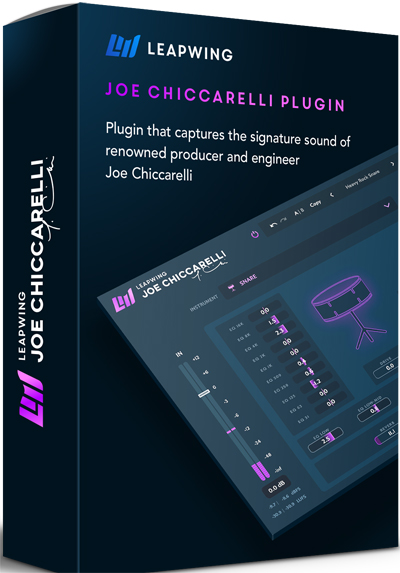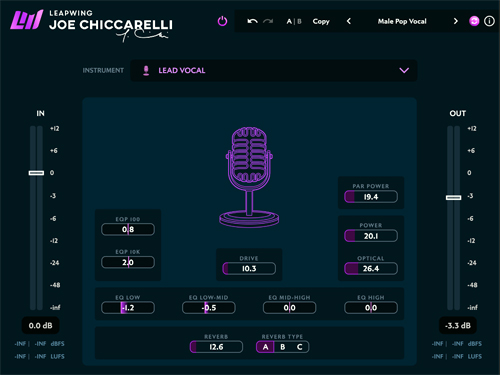 |
|
Leapwing Audio Joe Chiccarelli Signature Plugin Male Vocal Profile GUI |
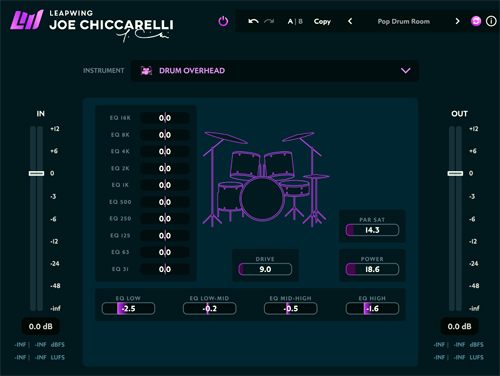 |
|
Leapwing Audio Joe Chiccarelli Signature Plugin Drum Overhead Profile GUI |
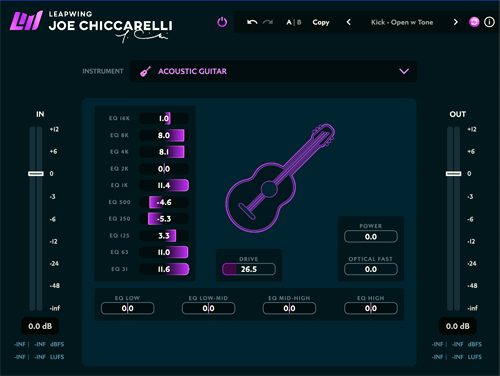 |
|
Leapwing Audio Joe Chiccarelli Signature Plugin Acoustic Guitar Profile GUI |
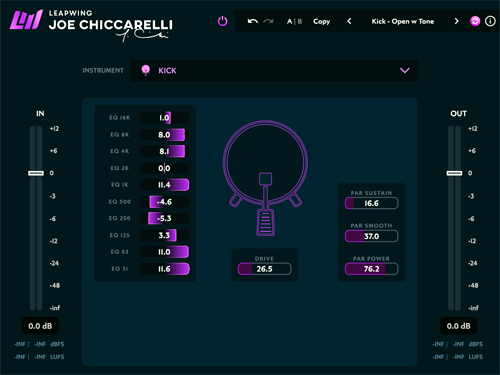 |
|
Leapwing Audio Joe Chiccarelli Signature Plugin Big Kick Profile GUI |
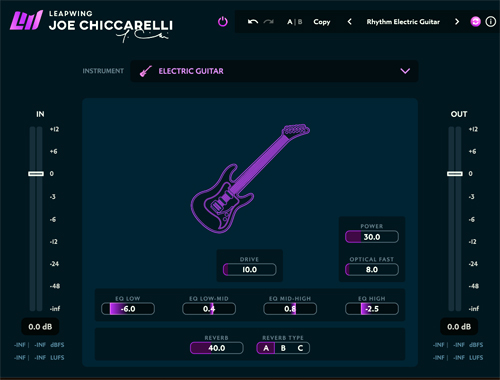 |
|
Leapwing Audio Joe Chiccarelli Signature Plugin Electric Guitar Profile GUI |
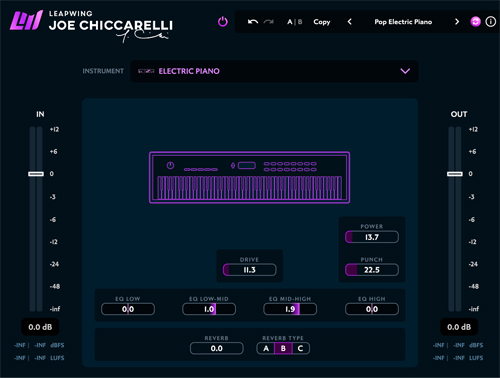 |
|
Leapwing Audio Joe Chiccarelli Signature Plugin Electric Piano Profile GUI |
What would Joe Chiccarelli do? The second plug-in in
Leapwing Audio's Signature Series was developed in
hand with producer/engineer and 10-time Grammy
and Latin Grammy winner Joe Chiccarelli. Compared to the first
plug-in in the Leapwing series, focusing on Al Schmitt, Chiccarelli
uses a more varied collection of outboard gear, which means
Leapwing has analyzed many more and different EQs, preamps,
compressors, distortion units, reverbs and effects to best represent
the mixer's engineering and mixing style.
The Joe Chiccarelli plug-in has 11 distinct Profiles, or processing
chains, specifically designed for: kicks, snares, toms, drum
overheads, drum rooms, bass DI, bass amp, acoustic guitar, electric
guitar, electric piano, and lead vocals. The plug-in is intended to be
an insert effect and comes with a resizable Retina interface. It works
at up to 384 kHz (DXD) sample rates, and the instrument Profiles
have low-enough latency to be usable in recording.
CHAINS OF PROCESSORS
Each Profile has its own set of emulated (hardware) processors in
specific chains that Chiccarelli would use on those instruments
or vocals. Only the processors with available parameters show up
when you select them, and there is no indication of the precise
order. Typically, the chain order would start
with Drive, then EQ or compressor, then parallel
compression, then output. (The Drive control
adds harmonic coloration based upon what is
required for the particular instrument or vocal.
Harmonic color comes from a blend of modeled
Neve 1073 and API mic preamplifiers.)
From there, depending on the Profile selected,
there are three different, emulated EQs used: an
API 560 10-band graphic; a 4-band, proportional
Q API 550B program EQ with different Profilespecific
shelf/peak and frequencies; and a
modeled Pultec EQP-1A only available in the
Vocal profile, with notated 100 Hz and 10 kHz
frequencies and up to ±8 dB boost/cut. I found
myself wanting to know what frequencies were
chosen in the 4-band EQ in each Profile.
Compressors and limiters also vary greatly
between Profiles with different models of LA2A
and LA3A in Optical Fast mode over to an UA
1176LN FET, or a dbx 160x VCA compressor/
limiter.
The available compressor/limiter parameters
also vary according to the Profile. The prefix
"Par" is added to the parameter name to indicate
a processor that runs parallel. The control
becomes a Wet/Dry balance.
The Sustain and Par Sustain controls model
Zener diode-based limiters for adding warmth.
Power and Par Power control a feedback-style
1176LN peak limiter, and Punch and Par Punch
control the dbx 160 compressor. If Par Smooth
comes up, then you're driving a Neve 33609
stereo compressor emulation, and you'll see
and hear it in the Snare profile! Finally, Optical
and Optical Fast Switch are available in some
Profiles--I liked it in the Electric Guitar profile
quite a bit. You cannot swap the compressors
around from one Profile to another.
The plug-in also has specific reverbs set up
with Chiccarelli's settings: an AMS DMX 15-
80 digital delay, AMS RMX 16 reverb, Lexicon
PrimeTime, and the echo chamber or one of
the two EMT plates at Sunset Sound Studios
in Hollywood, Calif. There is a simple fader to
control the amount.
IN THE STUDIO
I had a pop song to mix in Pro Tools HDX where
the producer was interested in getting a punchy
drum sound to drive an aggressive overall feel. I
started with a good-sounding drum kit recording
and inserted Leapwing JC on the kick and snare
The Snare drum profile will pop up ready to go
if you name the track "Snare"--it's called Track
Name detection, and it's supported in Pro Tools.
I love it because it is one less thing to do!
The kick drum got the Kick profile with the
10-band graphic zeroed out and just 6.7 of Drive
and 11.4 of Par Power. You can load a preset
with different kick drum sound settings from a
dropdown list, but I wanted to start from scratch
and start building my own preset collection.
I removed a lot of "knock" (-3.5 dB) using the
500 Hz fader in the 10-band graphic EQ and
pumped up 31 Hz to add some sub. I liked the
Drive control way up on this kick--I was at 75
and Par Sustain, Par Smooth and Par Power were
useful. Par Smooth added a nice attack that did
not sound like just adding a huge high-frequency
boost. I found that these Par controls should be
cranked toward 100 percent wet to make a real
difference.
The Snare drum track had both the 10-band
graphic and 4-band equalizer. This particular
track did not need a lot, but I loved a setting up
to 50 of Reverb C (there are three reverb choices)
effect on this stereo track, from Logic. I added a
little 16 kHz and 2 kHz, Drive was set to 30, and
Par Smooth was at 77. I had a snare sound in
minutes without inserting more plug-ins after it!
Whatever Profile you have selected, an icon
lights up in the center of the GUI showing input
signal presence, and a surrounding variable blue
glow indicates the amount of compression you're
using. It's not too exact but looks pretty cool, and
in a future update, the actual amount of gain reduction will be shown more conventionally.
A great engineering feature with this plug-in
is that both Input and Output levels are shown
as instantaneous dBFS and also K-Weighted
LUFS values just below the I/O meters.
VOCALS
For my Pop song mix, both lead and backing
vocals came together quickly with this plug-in.
I put the Lead Vocal profile on the female lead
vocal, with the EQP Pultec adding a smooth +10
at 10 kHz, otherwise flat in the EQ High section
of the 4-band EQ. The Drive, Par Power, Power
and Optical were at the default, and I just turned
off the reverb, preferring my own external reverb
treatment for this song. The singer stood out
from the track with a unique presence!
The Pultec is numerical (like the actual hardware),
while the rest of the EQs are calibrated in dB,
also like the actual hardware. Other than to
mouse down or option+click to zero out the
boost/cut control, there is no way to bypass any
of the individual EQ sections. The frequencies
of each of the 4-band EQs are only listed as EQ
Low, EQ Low Mid, EQ Mid-High and EQ High.
I particularly like the sound I got on this song's
stereo backing vocal track using the Female
Rock Vocal preset. The backing vocals were the
lead singer triple-tracked-three mono tracks
panned out a little left-right. Each of the three
tracks passed through an instance of Antares
Auto-Tune Pro and was mixed to a stereo aux
with one instance of the plug-in. I had Par Power
at 11.4, Power at 100, and Optical at 100. EQ Low
was only -1.8, Drive at 25.1, and Reverb C at 66.
This was powerful and big-sounding for just
three mono vocal tracks!
I took advantage of the Drive control a lot
on this plug-in--it "jumps up" the overall level
instantly to drive the compressors harder.
ONE-STOP PROCESSOR
The Leapwing Audio Joe Chiccarelli Plug-in is
a one-stop processor with so many uses--I'm
finding new ones all the time for all the Profiles,
even for instruments unrelated to the listed
ones. The chain of processors is carefully tuned
in these 11 Profiles to build a "produced sound"
easily and fast! Now I know "what Joe Chiccarelli
would do."
Highly recommended! The Leapwing Joe
Chiccarelli Plug-in is available at 64-bit in VST3,
AAX, and AU formats for macOS 10.10 and
higher and Windows 8 and 10.
 |
Barry Rudolph |
 |
|
Barry Rudolph is a recording engineer/mixer who has worked on over 30 gold and platinum award-winning records. He has recorded and/or mixed Lynyrd Skynyrd, Hall & Oates, Pat Benatar, Rod Stewart, The Corrs, Mick Jagger and Rick Rubin.
A three-time Grammy-nominated engineer, Barry has his own futuristic music mixing facility called Tones 4 $ Studios.
He is a lifetime Grammy-voting member of NARAS, the 'New Toys' columnist for LA's Music Connection Magazine and Contributing editor for Mix Magazine.
Check out: www.barryrudolph.com
www.gearlust.com |
|
 |
|
 | | |
 |
Leapwing Audio |
 |
|
Web: Joe Chiccarelli Signature Plug-in
Product: Joe Chiccarelli Signature Plug-in
Price: $159 MSRP
Pros: Instant access to punchy, solid signal
processing chains
Cons: I'd like to know the frequencies used in
the 4-band EQ in a Profile |
|
 |
|
 |
| |
Barry Rudolph is an L.A.-based recording engineer. Visit his Web site at:
WWW.BARRYRUDOLPH.COM

